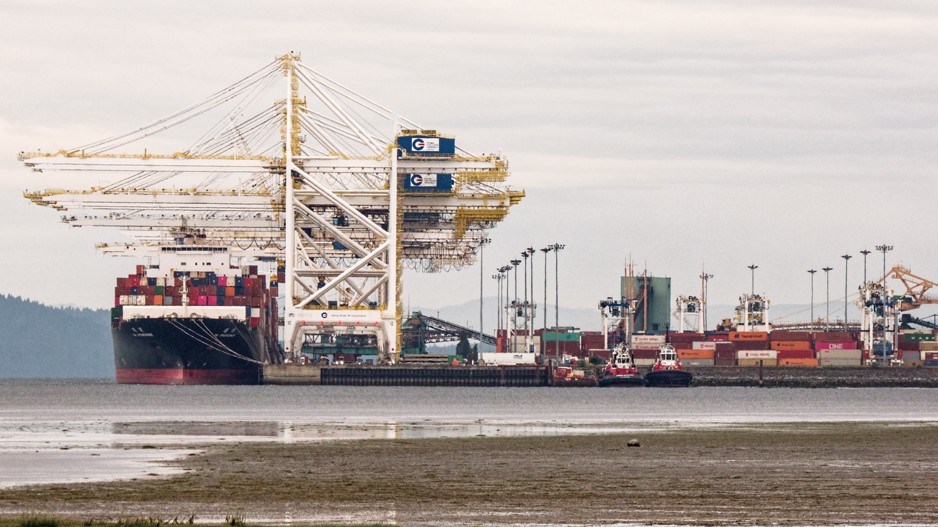Public response thus far following the federal government’s recent call for comment on the proposed $3.5 billion Roberts Bank Terminal 2 (RBT2) has been largely opposed to the project.
Comments posted on the Impact Assessment Agency of Canada’s (IAAC) website have come primarily from local Delta residents and community environmental groups.
Most have focused on the project’s potential impact on 177 hectares of Fraser River estuary waters that are critical for supporting migrating birds and local sea creatures. Despite the Vancouver Fraser Port Authority’s (VFPA) updated promise to create 86 hectares of habitat to replace the damaged estuary region, opponents say such plans are scientifically unproven and would likely be insufficient to offset the damage done from the project, which would use landfill to double the size of the existing 85-hectare Roberts Bank container terminal facility.
“To expand the port and make it even more industrial would be like paving over Stanley Park – unthinkable,” Tsawwassen resident Mary-Ellen Meyers said in a submitted comment. “The damage caused by this proposed port expansion will be irreversible.”
Several residents also pointed to expansion in other locations, including at the Port of Prince Rupert’s Fairview Terminal, as a more desirable and less environmentally disruptive way to expand container capacity along Canada’s West Coast.
The first stage of Fairview’s expansion is now 50% complete and on schedule to create Canada’s second largest container terminal by this summer. According to the Prince Rupert Port Authority and terminal operator DP World Canada, the first stage of Fairview’s Phase 2B expansion will be completed in July and will increase the terminal’s container cargo handling capacity to 1.6 million 20-foot-equivalent units (TEUs) from the current 1.35 million.
There was some support for the Terminal 2 plan in comments posted on the IAAC website.
Wrote Dean Olund, president of Richmond-based ContainerWest Manufacturing Ltd.: “I am in favour of the project proceeding through construction. I am more than comfortable with the level of detail and care given to environmental factors to date, and look forward to the project moving forward.”
Yet others did not share Olund’s optimism.
Some, like Delta resident Barney Reifel, focused their attention on a rival project – GCT Global Container Terminals Inc.’s Deltaport Berth 4 (DP4) – as a more appropriate way to increase container capacity at Roberts Bank.
The smaller expansion, proposed by the operator of the existing Deltaport container terminal, has been touted by GCT officials as being more “right-sized” and cost-efficient than the larger Terminal 2.
GCT and the VFPA have been locked in a legal dispute over GCT’s claims that the VFPA has prioritized its project while hampering DP4’s development, which GCT said is a conflict of interest.
The VFPA has said that RBT2’s capacity will be needed to address the container cargo demand in the 2030s. It also maintains that having another container terminal operator at Roberts Bank will ensure cost competition for ocean carriers loading and unloading in Vancouver.
The VFPA, in response to the public comment, said it plans to address some of the issues raised as the comment closing date of Feb. 13 approaches.
“We plan to provide a final submission during the public comment period, which will include feedback on the technical and economic feasibility of the draft conditions, as well as information on areas of interest that have been highlighted throughout the environmental assessment,” said Duncan Wilson, VFPA vice-president of environment and external affairs, in a statement.
Health Canada and Indigenous Services Canada both provided suggestions for amending the approval conditions as was laid out in December.
Health Canada said the IAAC should pay closer attention to Tsawwassen First Nation (TFN) reports on the project’s impact on the community’s social, cultural, economic and health (dietary) needs; Indigenous Services Canada implored the IAAC to maintain better transparency and access to TFN communities to address evolving demands.
Roger Emsley, executive director of the Against Port Expansion Community Group, said he is disheartened that Ottawa appears to be remaining silent on federal scientists’ view that man-made efforts cannot replace the Fraser River estuary’s unique biofilm.
Emsley added that the VFPA’s forecast of container demand that would justify RBT2’s construction is overly optimistic and too heavily reliant on U.S. container throughput.
“Why pour over $4 billion into building a terminal when there are viable, less expensive, more effective, alternatives elsewhere: Prince Rupert, cheaper, two days closer to Asia, better, less congested rail route to the east?” Emsley said.
“Why invest public funds when there are private investors willing to build more capacity elsewhere when it is needed, which currently it is not?” •




